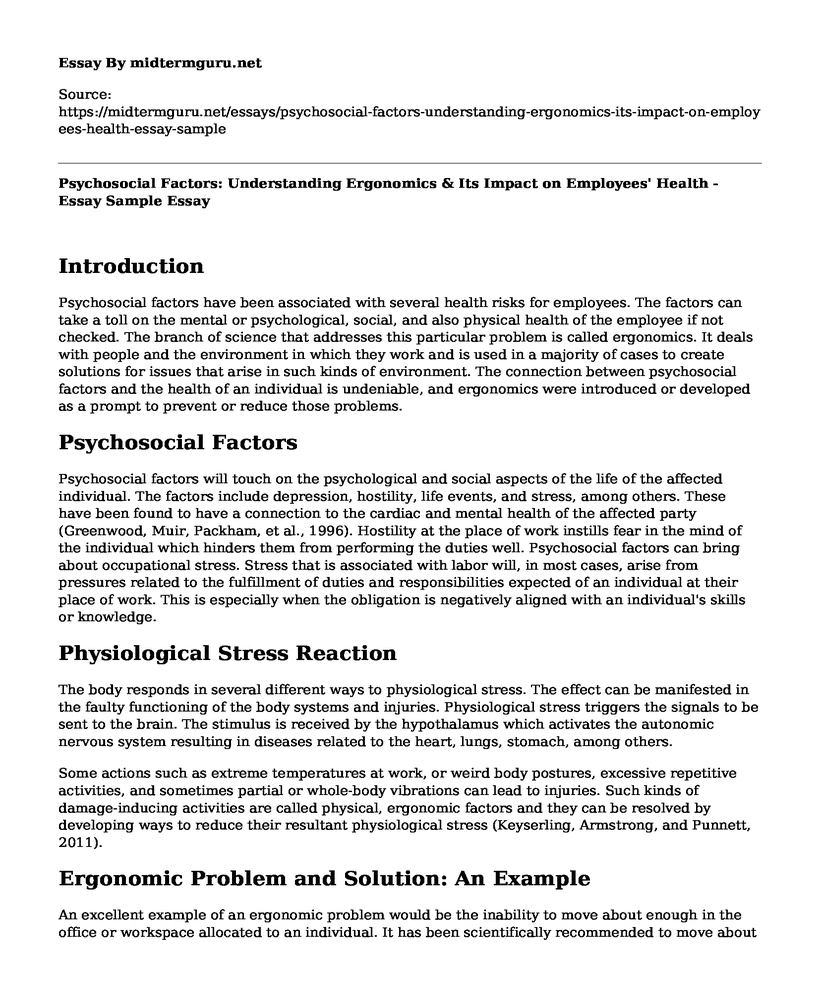Introduction
Psychosocial factors have been associated with several health risks for employees. The factors can take a toll on the mental or psychological, social, and also physical health of the employee if not checked. The branch of science that addresses this particular problem is called ergonomics. It deals with people and the environment in which they work and is used in a majority of cases to create solutions for issues that arise in such kinds of environment. The connection between psychosocial factors and the health of an individual is undeniable, and ergonomics were introduced or developed as a prompt to prevent or reduce those problems.
Psychosocial Factors
Psychosocial factors will touch on the psychological and social aspects of the life of the affected individual. The factors include depression, hostility, life events, and stress, among others. These have been found to have a connection to the cardiac and mental health of the affected party (Greenwood, Muir, Packham, et al., 1996). Hostility at the place of work instills fear in the mind of the individual which hinders them from performing the duties well. Psychosocial factors can bring about occupational stress. Stress that is associated with labor will, in most cases, arise from pressures related to the fulfillment of duties and responsibilities expected of an individual at their place of work. This is especially when the obligation is negatively aligned with an individual's skills or knowledge.
Physiological Stress Reaction
The body responds in several different ways to physiological stress. The effect can be manifested in the faulty functioning of the body systems and injuries. Physiological stress triggers the signals to be sent to the brain. The stimulus is received by the hypothalamus which activates the autonomic nervous system resulting in diseases related to the heart, lungs, stomach, among others.
Some actions such as extreme temperatures at work, or weird body postures, excessive repetitive activities, and sometimes partial or whole-body vibrations can lead to injuries. Such kinds of damage-inducing activities are called physical, ergonomic factors and they can be resolved by developing ways to reduce their resultant physiological stress (Keyserling, Armstrong, and Punnett, 2011).
Ergonomic Problem and Solution: An Example
An excellent example of an ergonomic problem would be the inability to move about enough in the office or workspace allocated to an individual. It has been scientifically recommended to move about every other 30 minutes to lower the risk of acquiring injuries in the musculoskeletal system and to also reduce the risk of early death. Such a problem would be tackled by prohibiting the carrying of water or fluids inside the working space and instead provide a common water point where every employee would have to walk to get drinking water. Since the employees are bound to obey the official rules, a lap around the working space every few minutes or hours can be cultivated as office culture. Placing printing hotspots at a walking distance from the offices would also help the employees to move more often since printing is an everyday activity in an office setup.
Managerial Proposal
The manager is responsible for making changes in the working environment to suit the ergonomic standards for all the employees. As a suitable pitch for the manager to buy into would be the prospect of a trained cardio specialist, employed by the company who guides the other employees in cardio exercises at specific times of the day. This way, on top of regular visits to the common water and printing points in the office, the workers can also release tension and avoid cardiovascular diseases through cardio exercises.
References
Greenwood, D. C., Muir K, R., Packham, C. J., et al. (1996). Coronary heart disease: a review of the role of psychosocial stress and social support. J Public Health Med; 18:221-31.
Keyserling, W. M., Armstrong, T. J., & Punnett, L. (2011). Ergonomic Job Analysis: A Structured Approach for Identifying Risk Factors Associated with Overexertion Injuries and Disorders. Applied Occupational and Environmental Hygiene; 6(5): 353-363 https://doi.org/10.1080/1047322X.1991.10387896
Cite this page
Psychosocial Factors: Understanding Ergonomics & Its Impact on Employees' Health - Essay Sample. (2023, Feb 07). Retrieved from https://midtermguru.com/essays/psychosocial-factors-understanding-ergonomics-its-impact-on-employees-health-essay-sample
If you are the original author of this essay and no longer wish to have it published on the midtermguru.com website, please click below to request its removal:
- How to Navigate the Relationship - Essay Sample
- Can Money Make You Happy? - Paper Example
- The Concept of Social Behavior - Research Paper
- Resistance: Active vs. Passive Protesting for Injustice - Essay Sample
- Mental Health: Its Impact on Development, Childhood, Adolescence & Adulthood - Essay Sample
- US Army Suicide: A Growing Mental Health Crisis - Essay Sample
- Exploring Demographics in Carrollwood, Florida, USA - Essay Sample







